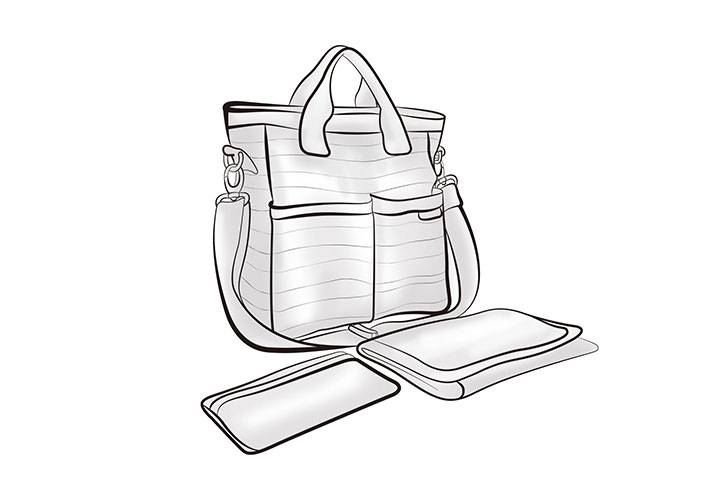Blogs & News
We have a lot of ideas and know-how about bags, material sourcing, sampling, production and a whole host of bag-related topics that we would like to share with you.
7 Ways Customization Can Boost Your DTC Brand’s Margins

In today’s fast-paced and highly competitive retail environment, Direct-to-Consumer (DTC) brands are increasingly turning to customization as a strategic tool. Customization not only meets the growing consumer demand for personalized products but also drives tangible financial benefits. In this article, we explore seven key ways that customization can significantly boost your DTC brand’s margins.
1、Higher Average Order Values
Customization often enables customers to add premium features, choose unique designs, or personalize products, which can justify higher pricing. This directly increases the average order value (AOV), a critical metric for margin growth, as it means more revenue per transaction without a proportional increase in variable costs.
Details: Customers are willing to pay more for products that feel tailored to their needs. Customization adds perceived value, allowing brands to command premium prices, especially in markets where consumers seek exclusivity. A 2022 BigCommerce report highlighted that personalization, including customizable options, can increase AOV by up to 15% (BigCommerce).
Example: DTC brands like Burrow expanded their product lines to include customizable options such as color, size, and material choices, which not only attracted more customers but also allowed for upselling. This strategy enabled Burrow to increase AOV, directly contributing to improved margins (BigCommerce). Similarly, Glossier offers customizable skincare routines through its “You+Me” program, supporting premium pricing and higher margins.
Margin Impact: Higher AOV means more revenue per sale, which, after accounting for variable costs, directly enhances contribution margins. For example, if a customized bag is priced at $100 compared to a standard $80, and variable costs remain $30, the margin increases from $50 to $70 per unit.

2、Reduced Inventory Costs
Customization, particularly through made-to-order or on-demand production, can significantly reduce inventory costs. Traditional retail models often require large stockpiles of inventory, leading to waste from unsold products. DTC brands, however, can minimize this risk by producing only what is ordered, aligning production with demand and reducing holding costs.
Details: Made-to-order models eliminate the need for excess inventory, reducing holding costs, storage fees, and the risk of markdowns on unsold stock. This lean approach is especially beneficial for DTC brands with limited physical retail presence, as it minimizes waste and lowers overhead. A 2024 report by Infosys BPM noted that optimizing fulfilment costs, including inventory management, can improve product margins by reducing cost of goods sold (COGS) (Infosys BPM).
Example: Brands like Allbirds and Warby Parker have successfully implemented made-to-order strategies, reducing inventory costs while offering customers a wide range of customizable options. For instance, Warby Parker’s home try-on program allows customers to customize their frame choice, producing only what is ordered, which minimizes waste (Ronsela). This approach lowers COGS, directly boosting margins.
Margin Impact: Lower inventory costs mean less overhead, directly improving profit margins. If a brand reduces inventory holding costs by 10%, the savings can be significant, especially for high-volume products, enhancing overall profitability.
3、Premium Pricing for Unique Products
Customized products are inherently unique, allowing DTC brands to charge premium prices. Customers are often willing to pay more for products that stand out or reflect their personal style, especially when they know the product is tailored specifically for them, adding exclusivity and perceived value.
Details: Customization adds exclusivity and perceived value, justifying higher price points. This is particularly effective in markets where consumers seek unique, high-quality products, and DTC brands can leverage direct customer relationships to highlight this value. A 2023 NielsenIQ study found that 73% of global consumers are willing to adjust their habits to reduce environmental harm, creating a ripe opportunity for eco-focused, customized brands (Ronsela).
Example: Glossier offers customizable skincare routines through its “You+Me” program, allowing customers to personalize their products. This not only enhances the customer experience but also supports premium pricing, directly boosting margins (BigCommerce). Similarly, Bombas offers customizable sock designs, which customers are willing to pay more for due to their uniqueness.
Margin Impact: Higher pricing on customized products directly increases revenue per unit, boosting margins. For example, if a customized bag is priced at $120 compared to a standard $90, and variable costs remain $40, the margin increases from $50 to $80 per unit, significantly enhancing profitability.

4、Enhanced Marketing and Word-of-Mouth
Customization can make products more shareable and desirable, leading to organic marketing through word-of-mouth and social media. This reduces reliance on paid advertising, lowering customer acquisition costs (CAC) and increasing overall profitability, as organic promotion amplifies brand reach at a lower cost.
Details: Unique, personalized products are more likely to be shared on social media or recommended to friends, creating a viral effect. This organic marketing is cost-effective and reduces the need for expensive paid campaigns, which is crucial for DTC brands facing high marketing costs. A 2024 Raindrop Agency report emphasized that DTC brands need 80%+ product margins to cover marketing costs, and customization can help by lowering CAC (Raindrop Agency).
Example: Bombas offers customizable sock designs, which customers often share on social media, driving organic traffic and reducing reliance on paid marketing. This lowers CAC, improving margins (Ronsela). Similarly, BarkBox’s themed, pre-packed boxes cater to urban dog owners, creating buzz and word-of-mouth, enhancing profitability (Avada).
Margin Impact: Lower CAC means more of each sale contributes to profit, improving margins. If a brand reduces CAC by 15% through organic marketing driven by customization, the contribution margin per customer increases, boosting overall profitability.
5、Increased Customer Loyalty and Repeat Business
Customization fosters a deeper connection between customers and brands, leading to higher loyalty and repeat purchases. When customers feel their preferences are valued and reflected in the products they buy, they are more likely to return for future purchases. This loyalty translates into increased lifetime value (LTV), which directly boosts margins by reducing the need for costly customer acquisition.
Details: Personalized products create an emotional resonance, making customers feel unique and valued. This emotional connection encourages repeat business and reduces churn, which is particularly crucial for DTC brands facing high customer acquisition costs (CAC). A 2023 study by McKinsey noted that 66% of consumers factor sustainability into purchases, with 26% willing to pay more for personalized products, suggesting a strong link to loyalty (Ronsela).
Example: Brands like M.M.LaFleur and ThirdLove have successfully leveraged customization through quiz-based product selection and try-before-you-buy programs, respectively. M.M.LaFleur tripled its revenue after introducing its Bento Box quiz, while ThirdLove saw 75% of customers become repeat buyers after implementing their try-before-you-buy program (Indigo9Digital). This demonstrates how personalization can enhance customer retention, directly impacting margins.
Margin Impact: Higher customer retention means less reliance on expensive marketing, allowing more revenue to flow into margins. For instance, if a brand reduces CAC by 20% through repeat business, the contribution margin per customer increases, improving overall profitability.
6、Lower Returns with Better Fit
Customization ensures products better match customer expectations, reducing return rates—a significant cost driver in DTC e-commerce—and preserving margins. Tailored products align with preferences, minimizing dissatisfaction and the associated costs of reverse logistics.
Details: Personalized experiences can cut returns by up to 25%, according to a 2023 Kustomer report, by ensuring products fit customer needs from the start. This is particularly relevant for DTC brands, where returns can erode margins due to shipping and processing costs. Warby Parker’s home try-on program, paired with customization, exemplifies this, reducing return rates and saving on costs (Ronsela).
Example: Warby Parker’s program allows customers to try frames at home, customizing their choice, which lowers returns. This saves on reverse logistics, directly boosting margins by reducing costs. Similarly, DTC bag brands offering customizable sizes or features can see similar benefits.
Margin Impact: Reducing returns from 20% to 15% on $100,000 in sales saves $5,000, directly boosting net margins, as seen in the example.

7、Differentiation in a Competitive Market
Customization sets your brand apart, attracting customers willing to pay for uniqueness and reducing price competition, which can erode margins. A distinct offering strengthens brand identity, allowing you to maintain pricing power and avoid discounting, preserving margin levels.
Details: A 2024 Avada report cites differentiation as a top driver of DTC success, and customization enables this by offering unique, tailored products. This reduces the need to compete on price, maintaining higher margins. July Luggage’s personalized travel bags stand out in a crowded market, enabling consistent margins despite competition (July).
Example: July Luggage offers customization like color and monogramming, setting it apart from competitors and allowing premium pricing without discounts. This preserves margins, as seen in their market positioning.
Margin Impact: Avoiding discounts (e.g., maintaining $100 vs. dropping to $85) preserves a $15-per-unit margin advantage, directly enhancing profitability.
Best Practices for Implementing Customization
To maximize the margin-boosting potential of customization, DTC brands should:
Leverage Data Analytics: Use customer data to identify personalization opportunities, aligning with preferences to enhance loyalty and AOV.
Partner with Flexible Manufacturers: Collaborate with manufacturers offering end-to-end customization, ensuring quality and efficiency, as seen in the examples above.
Communicate Value: Highlight customization in marketing to justify premium pricing and drive word-of-mouth, reducing reliance on paid ads.
Optimize Fulfilment: Ensure logistics support made-to-order models, reducing inventory costs and enhancing customer satisfaction.

Conclusion
By focusing on these seven ways, DTC brands can create a strategy that not only attracts traffic to their platforms but also fosters long-term profitability through enhanced margins. Start with a mix of personalization strategies, such as quiz-based recommendations and made-to-order options, to build initial interest and trust.

